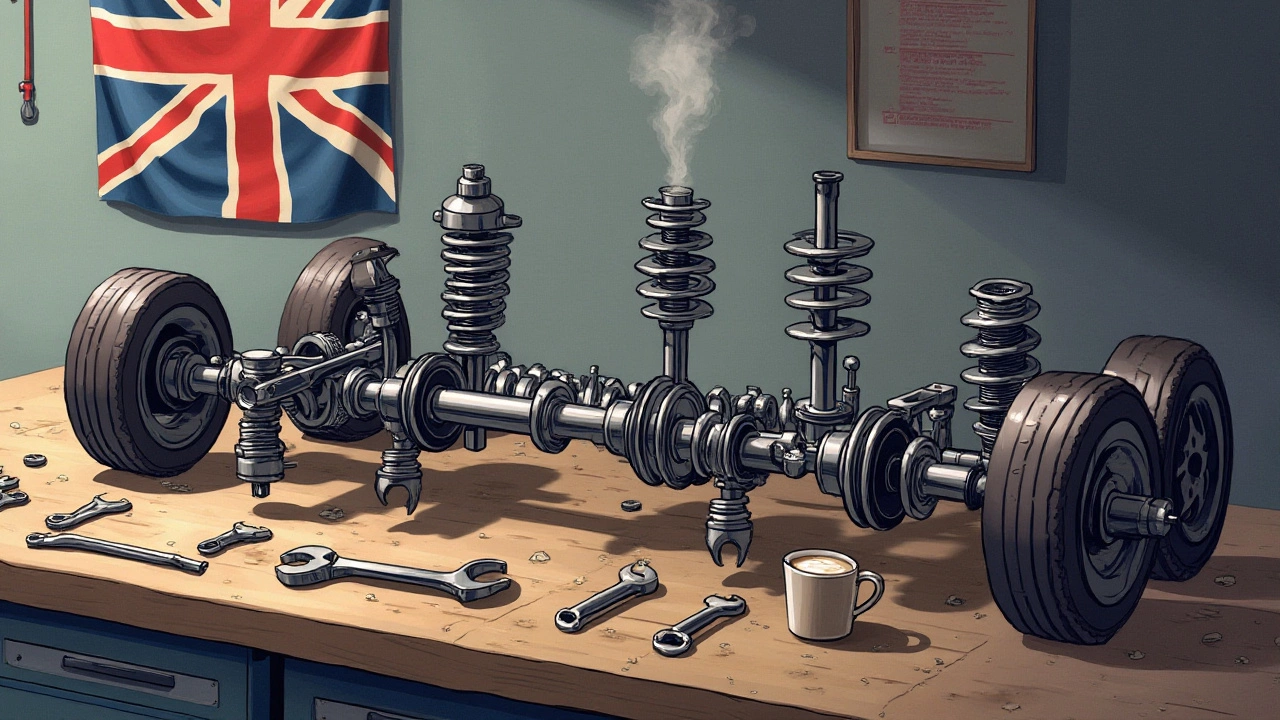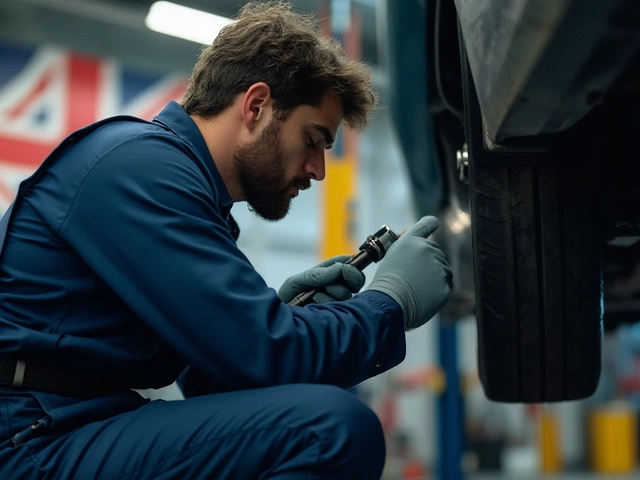Driving your car should feel smooth and predictable, but sometimes things can go awry beneath the surface. If your vehicle feels more like a bucking bronco than a smooth ride, it might be time to check the struts. Car struts play a critical role in your suspension system, ensuring that your ride remains comfortable and controlled.
But how do you know when it's time for a strut replacement? Does that strange noise or bumpy feel mean anything significant? There's no need to call the mechanic just yet. By familiarizing yourself with the telltale signs of failing struts, you can take steps to keep your vehicle in tip-top condition.
- Understanding Struts and Their Role
- Common Symptoms of Failing Struts
- Impact of Bad Struts on Vehicle Performance
- How to Inspect Your Struts at Home
- Professional Help and Repair Costs
- Maintenance Tips for Prolonging Strut Life
Understanding Struts and Their Role
The world of automobiles is fascinated by its complexity, and within this intricate web, the role of the struts is both critical and often overlooked. Think of struts as the unsung heroes of your car’s suspension system. They are pivotal not only for ensuring a smooth ride but also for maintaining stability on various surfaces. Struts combine several functions within a single unit, acting as a structural part of the suspension like a shock absorber while supporting the coil spring. This remarkable fusion allows struts to control the spring and suspend your vehicle's weight, which significantly enhances the car’s ability to absorb road irregularities.
Carrying the vehicle's weight and providing structural support are just the tip of the iceberg when it comes to the importance of struts. These components are essential for steering and alignment, helping to improve handling and ensuring that tires maintain contact with the road. This can prevent accidents caused by loss of control and contributes to better fuel efficiency by reducing tire wear and improving ride quality. In this regard, maintaining your struts is not just about comfort, but key to your vehicle’s performance and, ultimately, your safety. Interestingly, statistics show that nearly 90% of drivers are unaware of the critical role struts play in their cars, until a problem arises.
The importance of struts is often highlighted by automotive experts. As noted by an engineer from a renowned automotive magazine,
"Without well-functioning struts, driving can quickly become a hazardous affair, akin to trying to run on broken legs."This analogy not only emphasizes the necessity of struts but also underscores the importance of their maintenance. Regular inspection can forestall potentially dangerous situations and save you hefty repair costs down the line. Car experts often advise having your struts checked every 50,000 miles to detect wear and tear before they lead to bigger problems.
The intricate relationship between the various components of the suspension system can easily be visualized in their interconnected functionalities. While struts are crucial in maintaining the vertical position of the car through damping road shocks, they also aid in leveling the vehicle and providing better traction. By holding the vehicle's body steady, struts manage forces from bumps and turns, and in turn, safeguard the structural cohesion of components such as the chassis and tires. Understanding how these elements synchronize underlines yet another reason why regular strut inspections are key to preserving the longevity and efficiency of both your suspension system and your entire vehicle.
For the DIY enthusiasts, recognizing the unique role of the struts offers a gateway into more personalized car care. Replacing or upgrading struts can be a gratifying experience, not only breathing new life into your vehicle's suspension but potentially enhancing ride comfort and handling to levels you may not have experienced before. However, due to the complexity involved, it's advisable to undertake such projects with access to the proper tools and guidance, or, more practically, consult with a professional mechanic. Regardless, staying educated on the role and functionality of suspension components can empower you to make informed decisions, ensuring that every ride is as safe and pleasant as possible.
Common Symptoms of Failing Struts
In the realm of vehicle maintenance, understanding the symptoms of bad struts is crucial for ensuring your car runs smoothly on the road. Imagine you're cruising along a familiar route when suddenly, your ride starts feeling less than smooth and more like a rollercoaster that refuses to end. This discomfort is often an indicator that your vehicle’s struts might be reaching the end of their lifecycle. One of the primary signs includes excessive bouncing or rocking, sometimes even after the vehicle has hit only a minor bump or pothole. Your vehicle should settle quickly after these disturbances; when it doesn't, it spells trouble for the struts.
A vital symptom that car owners frequently overlook is uneven tire wear. While it’s common for tires to wear out, seeing specific sections of a tire worn thinner than the rest hints at more profound issues. This irregular wear is often due to strut problems, as struts are instrumental in maintaining proper wheel alignment and tire-to-road contact. Ignoring this symptom could lead to increased fuel consumption and even more serious damage over time. Another telltale sign is a noticeable dip in the front of your car when braking. Ideally, the suspension system should keep your vehicle level, so a forward lunge suggests ineffective struts.
Listening closely to your car can also offer clues. Unfamiliar clunking, knocking, or even squeaking noises while navigating bumps or turns is another common symptom. These noises often stem from the struts' internal components failing or coming loose, which not only compromises comfort but also your vehicle’s safety. Another obvious yet often underestimated sign is simply difficult handling. If you notice your vehicle swaying or drifting more than usual, particularly in windy conditions or around turns, your struts could be the culprits.
Struts are fundamental to the suspension system, acting not only as shock absorbers but also as components responsible for vehicle alignment and road handling. Addressing their failure swiftly is crucial to avoid cumulative problems. As the American College of Surgeons puts it, "The key to longevity and durability often lies in attentive observation and timely intervention." Attaining this insight about your car’s anatomy equips you with the tools to prolong the life of your vehicle, avoiding unnecessary mechanical mishaps down the line.
To sum it all up, frequently inspecting your suspension parts is not just recommended but essential. Understanding these symptoms helps ensure your vehicle remains safe and reliable. Maintaining a regular check regimen can considerably extend the life of your car’s struts. Additionally, document any changes in performance or ride quality. Doing so allows for a more accurate assessment, ensuring that you remain on track with your car's maintenance needs.

Impact of Bad Struts on Vehicle Performance
When it comes to understanding the significance of struts in your car, think of them as the unsung heroes of your vehicle's suspension system. Bad struts symptoms can play havoc with the way your car performs on the road. One of the first things you might notice is how your vehicle responds to bumps and potholes. If every little bump becomes a jolt, it’s likely that your struts need attention. Not only does this make the ride uncomfortable, but it can also compromise your control over the car, turning everyday drives into a white-knuckled experience. Struts help maintain contact between the tires and the road, a crucial aspect when driving on uneven surfaces.
The uncomfortable shaking and bouncing aren’t just annoying. They signal a deeper issue with your vehicle's suspension system.
"A vehicle's suspension is essential in ensuring optimate tire friction with the road surface. Without it, safety and performance are compromised," notes automotive expert Henry Thomason.When the car suspension issues escalate due to worn-out struts, handling turns becomes riskier. You'll feel the body of your car lean excessively as you corner, and that lean might seem harmless until a quick maneuver in traffic becomes necessary. During high-speed turns, you're at greater risk of losing traction, which might result in dangerous situations like skidding. This is why maintaining proper suspension is not merely about comfort—it's a matter of safety.
Another critical factor to consider is the impact on tire wear. Failing struts mean your tires bounce excessively, which unevenly wears down their surface over time. You might notice what's known as cupping—a specific kind of irregular wear pattern that's hard to miss. These uneven patterns not only lead to costly replacements but could also degrade the effectiveness of your tires well before their typical lifespan ends. This means an increase in those unexpected expenses that all of us dread. Beyond that, a car with tire wear issues tends to have lower fuel efficiency, adding to your monthly expenses at the pump.
One significant—but often overlooked—impact is on alignment. Bad struts can alter the alignment of the wheels, pushing them out of sync over time. When wheels are misaligned, the steering wheel might vibrate or drift to one side even on straight roads. Regular trips to get an alignment check and fix cost not only money but also time, and nobody wants to spend their weekends or work hours at a mechanic rather than enjoying life. This misalignment can stress other parts of the suspension too, leading to a domino effect as more components bear the brunt of the failing struts.
Finally, the insidious nature of neglecting suspension repairs manifests itself in the larger picture—potential damage to other systems of the vehicle. A run-down suspension can place undue stress on the chassis and can have repercussions on things like the exhaust and braking systems. Parts that should last for years find their lifespans cut short, leading to prefacing issues you might not have anticipated. Knowing all this, there’s little doubt that attending to strut issues in time can save not just the effort but also extend the life of your beloved vehicle.
How to Inspect Your Struts at Home
Checking your car's struts at home might seem a bit daunting, but with a little patience and the right guidance, it can be done effectively. Start with a visual inspection; this doesn't mean you have to get down and dirty just yet. Position your car on a level surface and get the tires straight. Look for signs of fluid leakage around the struts; dampness may indicate that they have reached the end of their useful life. Struts are integral to a well-functioning vehicle, and spotting leaks early can save you from expensive repairs. If you're noticing persistent puddles beneath your vehicle, take action sooner rather than later.
Once you've done with the visual check, it is time to evaluate the vehicle's suspension manually. Push down each corner of the car firmly, then release. The car should bounce softly, returning to its natural position without a fuss. If it bounces more than once or twice, your strut may be the culprit. This simple bounce test can be a revealing indicator of the wear status of your struts. As an aside, poorly cushioned rides aren't just uncomfortable – they're a hazard.
Diving a little deeper, the next step involves inspecting the tires. Unusual tire wear is the whispering warning of struts demanding attention. Uneven wear patterns might betray issues with your suspension. Cupping or scalloping is a telltale sign of failing struts. Tires that consume their tread unevenly are typically symptomatic of bigger problems looming underneath. Keeping up with regular tire rotations might mask these issues, so it's essential to separate tread health from the suspension's.
Listening Carefully
Your senses don't stop at touch and sight; sound can be an invaluable ally in diagnosing suspension issues. Climb into your car, drive over a few bumps, and listen. Do you hear any suspicious clunking or rattling? These could be ominous signs of distress within the struts. As automotive expert Chris Fix points out, "Ignoring early noises can significantly shorten the lifespan of more than just your struts."
Never underestimate the power of your nose, either. Burning oil or a sweet scent that reminds you of antifreeze may mean a leak has reached the point where other components are being affected. This isn't just about comfort anymore; it's about securing safety behind the wheel.
| Strut Condition | Recommended Action |
|---|---|
| Dry and Firm | No immediate action needed |
| Leaking Slightly | Monitor and plan replacement |
| Excessive Leak/Noise | Immediate replacement required |
When in doubt, never hesitate to get a second set of eyes (and ears) on the issue. Consulting a professional will leave you more informed and potentially save you from a costly mistake in diagnosis. But with these steps, you'll approach these conversations with a stronger hand, knowing what signs to bring to their attention.

Professional Help and Repair Costs
When it comes to dealing with bad struts symptoms, many drivers find relief in turning to professional mechanics. Experienced technicians have the knowledge and tools needed to identify issues accurately and quickly. But before diving into the costs, it's important to appreciate the level of expertise these professionals bring to the table. They don't just replace a part; they evaluate your car's overall suspension system to ensure every component is working harmoniously. This holistic approach can often catch issues before they spiral into bigger, costlier problems.
Now, let's talk dollars and cents. The cost of replacing car suspension issues can vary widely, depending on your vehicle make, model, and where you live. On average, you might be looking at a price range from $150 to $450 per strut. Labor costs can add another $100 to $300 to the bill, given the time-intensive nature of the job. It's worth noting that many professionals advise replacing struts in pairs to maintain balance and stability, which can double your expenses. But, in the long run, this investment can save on potential damage to other parts of your suspension system.
Professional repairs also come with a guarantee of sorts. Many auto shops offer warranties on their work, ranging from one year to a lifetime—the peace of mind that comes with knowing your vehicle maintenance is covered for future mishaps. As one mechanic I've spoken to before put it, "There's a lot of value in ensuring the job is done right the first time." This assurance can be invaluable, especially for those of us who rely heavily on our cars every day.
For those considering a DIY approach, it's important to remember that despite the extensive video tutorials available online, replacing struts requires precision and specific tools not commonly found in an average home workshop. Plus, incorrectly installed struts could lead to compromised safety—a risk not worth taking. Thus, unless you are experienced with automobile repairs, entrusting this task to a professional is often the best choice.
Should budget constraints be a concern, you might want to consider discussing payment options with your auto shop. Some garages might offer financing plans or discounts during certain times of the year. It's always a wise move to call around and get a few quotes before committing. With knowledge and preparation, you can make an informed decision that balances both safety and cost efficiency.
I hope this sheds some light on what to expect when seeking help from professionals to fix your struts. This kind of understanding can transform a daunting repair into a manageable task and ensure your car continues to ride smoothly and safely.
Maintenance Tips for Prolonging Strut Life
Ensuring the longevity of your car's suspension system isn't just about knowing when something's gone wrong; it's largely about taking proactive steps to maintain your struts. These vital components toil tirelessly beneath your vehicle to cushion its movements and stabilize its trajectory. To stretch their lifespan, you must often inspect and maintain vital car areas. This seems daunting at first, but trust that regular upkeep is your secret weapon against premature damage.
Start by keeping an eye on your tire alignment. Misaligned tires seldom work in harmony with struts. Over time, this tension wears down both parts faster than they can handle. Schedule alignment checks at least once a year, perhaps during your semi-annual oil change. Tires aligned to specification don't just extend strut life but boost fuel efficiency and vehicle control. One could consider it a three-for-one maintenance move.
Don't underestimate the power that simple cleanliness holds, too. Dirt and debris have a knack for working their way into your vehicle's undercarriage. Over time, they'll accumulate around suspension components, causing wear and potential damage. Regular washing of your car, especially post-road trips, clears out this harmful debris. While you’re at it, inspect the struts for any signs of fluid leakage which could indicate worn seals—a precursor to more significant problems.
Driving habits also play a substantial role in the wear and tear of struts. While it may be fun to test the limits on turns at higher speeds, or to neglect slowing for that rogue pothole, these habits take a toll on the suspension. Speed bumps are meant to suggest caution for a reason. Embracing smoother driving practices rewards you with longer-lasting parts and safer travels. It is wise to remember that, as Leo Tolstoy once suggested, "The two most powerful warriors are patience and time."
Routine inspections are indispensable. Visual inspections can be done at home; check your car for uneven tire wear, excessive bouncing, or clunking noises. When in doubt, consult a professional. Having a mechanic inspect your suspension during regular servicing can mean catching issues early before they spiral into costly repairs. Take the word of many vehicle manual experts: regularity indeed saves money.
Lastly, don’t ignore the signs of trouble. If unusual noises or handling discrepancies arise, address them immediately. Ignoring early symptoms of strut problems might not only endanger your vehicle’s health but could compromise your safety on the road. Regular check-ups help keep your vehicle performing at its peak, ensuring you stay safe while avoiding unexpected breakdowns.








